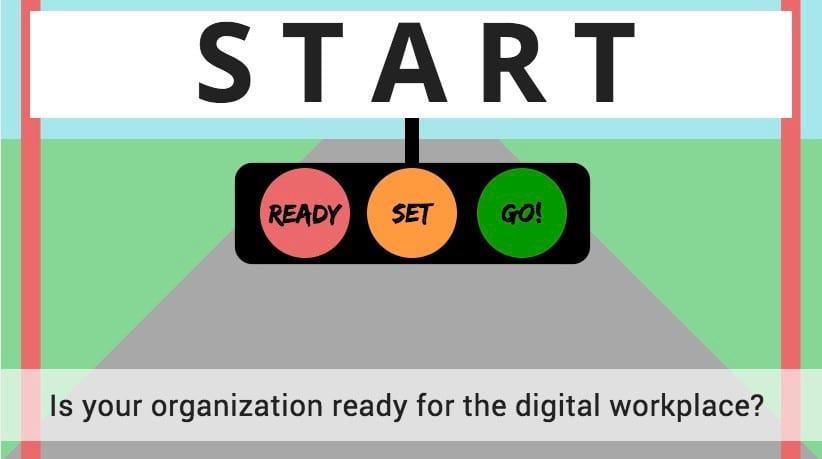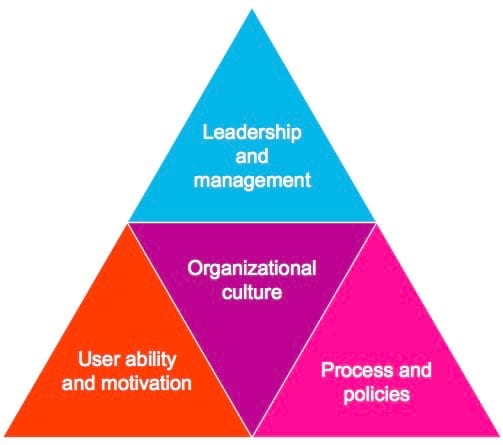How can I know if my organization is ready for digital working?
 We’ve all been there. You hear about a new app intended to help you change your habits. You download it to your phone. It’s life-changing for a few days, or even weeks. “This is it,” you marvel, “my life is changed forever!” Then you miss a day. Then a week. And, before you know it, your behaviour reverts to life before the so-called silver bullet app.
We’ve all been there. You hear about a new app intended to help you change your habits. You download it to your phone. It’s life-changing for a few days, or even weeks. “This is it,” you marvel, “my life is changed forever!” Then you miss a day. Then a week. And, before you know it, your behaviour reverts to life before the so-called silver bullet app.
Behaviour change on an individual level is hard. Scale it up, to multiply individual behaviour change to a whole organization, and you start to get a feel for why so many digital workplace initiatives struggle to gain real traction.
This is where the concept of organizational readiness comes into play.
What is organizational readiness?
A plethora of elements interweave to contribute to the success (or breakdown) of your digital workplace efforts: from the technology ecosystem and device experience, to the physical context in which these are being deployed and the diversity of your user types.
Organizational readiness is one of these elements, and it taps into some of the less tangible areas often viewed as being beyond the control of digital workplace efforts, such as culture, management style and organizational process.
Without the necessary practices in place, the best technically designed digital workplace in the world will struggle to gain traction. This is where organizational readiness comes in. It’s a way of assessing to what extent your environment is ready for digital working, so that you can plan what interventions will help you close any gaps.
Thinking back to our app: it’s not just relying on the technology to change our behaviour; it’s thinking also about our support network, routine, mindset, and the nudges we need in order to truly change.
But what does organizational readiness actually look like?
It’s not enough to talk about organizational readiness in the abstract; we need to know what elements actually constitute an organization that is ready to embrace digital ways of working.
DWG’s research, Is your organization ready for the digital workplace?, has identified four key areas of organizational readiness. Each of these contains a number of “truth statements” that can help you assess how ready your organization is as well as establish any potential gaps that may hinder your digital workplace efforts. While the full report covers these areas in detail, we’ve picked out some key indicators below.

Area of organizational readiness | Description | Sample readiness indicators |
Leadership and management | For an organization to have |
|
Process and policies | Organizational readiness for digital working therefore requires the right processes and policies to be in place so that employees are fully supported by the infrastructure surrounding them; |
|
Organizational culture | While culture change is a long-term effort that goes beyond the realms | DWG has identified 13 specific values that can facilitate digital working, depending on to what extent they are present within the organization.Find out more. |
User ability and motivation | Where user motivation falls on the spectrum of low to high, and user ability falls on the spectrum of whether the behaviour is hard or easy to do, will both influence to what extent the trigger for the desired behaviour is successful. When viewed through the lens of organizational readiness for digital working, BJ Fogg’s Behavior Change Model can therefore be a helpful framework for ensuring that the necessary practices are in place to encourage high |
|
So what can I do?
As with anything, it helps to know where you want to go, assess where you are now, and then plan how you’re going to address any gaps.
While our research has identified additional indicators, you can make a start with the information provided above through a simple stocktake of what you already know.
Create a four-column table, and work through the following:
- List each of the above indicators in the far-left table column.
- In the next column to the right, brainstorm to what extent you see evidence for this indicator within your organization (or even within a specific department or different user groups).
- Assess whether this is most likely to help or hinder your digital workplace efforts.
- Identify practical actions and interventions you can take to try and alleviate any issues.
Related research and resources
Organizational readiness research
Categorised in: Digital workplace, Research reports


